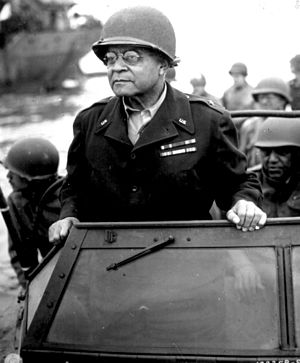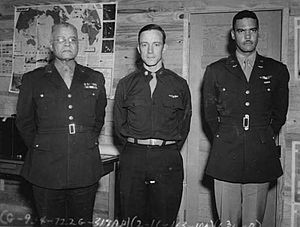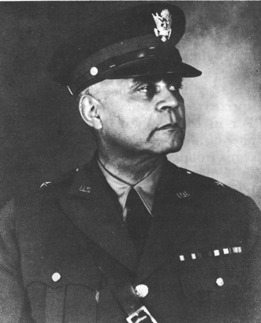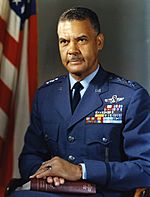Benjamin O. Davis Sr. facts for kids
Quick facts for kids
Benjamin Oliver Davis Sr.
|
|
|---|---|

Davis in France on August 8, 1944
|
|
| Born | May 1880 (per census document) July 1, 1877 (official) Washington, D.C., United States |
| Died | November 26, 1970 Aged 90 (per census document) Aged 93 (official) Chicago, Illinois, United States |
| Place of burial |
Arlington National Cemetery, United States
|
| Allegiance | |
| Service/ |
|
| Years of service | 1898–1948 |
| Rank | |
| Unit | 9th Cavalry |
| Commands held | 369th Infantry Regiment 4th Cavalry Brigade |
| Battles/wars | Spanish–American War Philippine–American War World War I World War II |
| Awards | Distinguished Service Medal Bronze Star French Croix de Guerre Africa Star |
| Relations | Son – Gen. Benjamin O. Davis Jr., USAF |
Benjamin Oliver Davis Sr. (born July 1, 1877 – died November 26, 1970) was a very important officer in the United States Army. In 1940, he made history by becoming the first African-American to reach the high rank of brigadier general. He was also the father of Benjamin O. Davis Jr., who became a brigadier general in the United States Air Force.
His career was special because it showed a small but important step forward for African Americans in the U.S. Army. During World War II, he helped with important tasks to support African-American soldiers, even though the army was still segregated at the time.
Contents
Early Life and Education
Benjamin O. Davis Sr. was born in Washington, D.C.. He was the third child of Louis P. H. Davis and Henrietta Davis. Some records suggest he might have been born in May 1880. It's thought he might have changed his age to join the Army without his parents' permission. However, the date on his gravestone at Arlington National Cemetery is July 1, 1877, which is the date he gave to the Army.
He went to M Street High School in Washington, D.C., where he was part of the school's cadet program. His parents wanted him to go to college after high school. But Benjamin Davis decided he wanted to join the military instead.
Military Career Highlights
Davis began his military journey on July 13, 1898, during the Spanish–American War. He joined as a temporary first lieutenant in an all-African-American unit. After this, he enlisted as a private in the 9th Cavalry Regiment in 1899. This was one of the famous Buffalo Soldier regiments.
While serving in the 9th Cavalry, he met Lieutenant Charles Young. Young was the only African-American officer in the U.S. military at that time. Young encouraged Davis to become an officer too. He helped Davis study for the officer test, especially with math. In 1901, Davis passed the test and became a second lieutenant in the Regular Army.
His early career involved many different assignments:
- Serving in the Philippine–American War from 1901 to 1902.
- Teaching military science at Wilberforce University in Ohio for four years.
- Working as a military helper in Liberia from 1910 to 1911.
- Patrolling the Mexican-United States border with the 9th Cavalry in 1913.
- Serving in the Philippines again during World War I from 1917 to 1920.
After World War I, Davis continued to teach military science. He worked at the Tuskegee Institute in Alabama and later with the Ohio National Guard. From 1930 to 1933, he also helped escort mothers and widows of World War I soldiers to visit their loved ones' graves in Europe.
In 1938, he took command of the 369th Regiment, New York National Guard. Then, on October 25, 1940, Benjamin O. Davis Sr. was promoted to brigadier general. This made him the very first African-American general officer in the United States Army.
World War II Service

During World War II, General Davis played a key role. In 1941, he became the commanding general of the 4th Cavalry Brigade. Soon after, he moved to Washington, D.C., to work in the Office of the Inspector General. In this role, he helped oversee policies for African-American troops.
From 1941 to 1944, he traveled around the United States and Europe. He inspected African-American soldiers and their units. His work was important in helping to improve conditions and support for these soldiers. He also helped suggest a new policy to integrate troops using replacement units.
Retirement and Later Life
After World War II, General Davis continued to serve. He worked as a special assistant to the Secretary of the Army. In 1947, he went to Liberia again to represent the United States during their country's 100th anniversary celebration.
On July 20, 1948, after 50 years of service, General Davis retired from the Army. President Harry S. Truman was there for his retirement ceremony. Just six days later, President Truman signed Executive Order 9981. This order officially ended racial segregation in the United States armed forces.
After retiring, Davis continued to serve his country. From 1953 to 1961, he was a member of the American Battle Monuments Commission. This group helps maintain U.S. military cemeteries and memorials around the world.
Benjamin O. Davis Sr. passed away on November 26, 1970, in Chicago, Illinois. He was buried with his wife, Sade Overton, at Arlington National Cemetery.
Legacy and Family
In 1997, the United States Postal Service honored General Davis by issuing a 32-cent stamp with his picture.
Davis married Elnora Dickerson in 1902. They had a daughter, Olive, in 1905, and a son, Benjamin O. Davis Jr., in 1912. Sadly, Elnora died in 1916 after giving birth to their second daughter, Elnora. Davis's parents helped care for his children while he was on duty. In 1919, he married Sarah "Sadie" Overton, who was an English teacher. They were married for 47 years until Sadie passed away in 1966.
His son, Benjamin O. Davis Jr., followed in his footsteps. He became the first African-American general officer in the United States Air Force in 1954.
Awards and Honors
General Davis received many awards for his service, including:
- Distinguished Service Medal
- Bronze Star Medal
- Spanish War Service Medal
- Philippine Campaign Medal
- Mexican Border Service Medal
- World War I Victory Medal
- American Defense Service Medal
- American Campaign Medal
- European-African-Middle Eastern Campaign Medal
- World War II Victory Medal
- Army of Occupation Medal
He also received awards from other countries:
- Commander of the Order of the Star of Africa (Liberia)
- Croix de Guerre with Palm (France)
In 1943, he was given an honorary Doctor of Laws degree from Atlanta University in Atlanta, Georgia.
Images for kids
See also
 In Spanish: Benjamin O. Davis Sr. para niños
In Spanish: Benjamin O. Davis Sr. para niños




